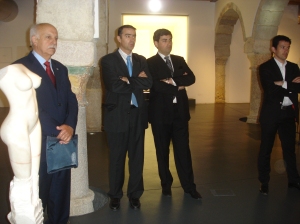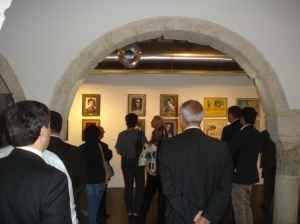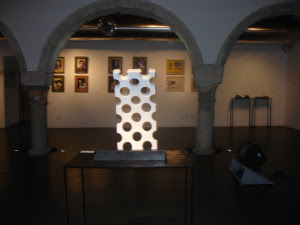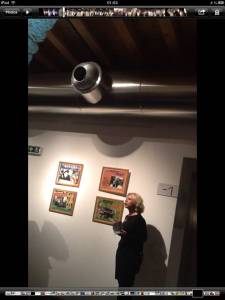quem somos
QUEM SOMOS
O Casa Amarela 5B -Jornal Online surge da vontade de vários artistas, de, num esforço conjunto, trabalharem no sentido de criar uma relação forte com o público e levando a sua actividade ao seu conhecimento através do seu jornal online.
Este grupo de artistas achou por bem dedicar o seu trabalho pintorNelsonDias, https://www.facebook.com/pages/Nelson-Dias/79280420846?ref=hl cuja obra terá sido muito pouco divulgada em Portugal, apesar de reconhecido mérito na banda desenhada, a nível nacional e internacional e de várias vezes premiado em bienais de desenho e pintura.
Direcção e coordenação: Maria João Franco.
O Casa Amarela 5B -Jornal Online surge da vontade de vários artistas, de, num esforço conjunto, trabalharem no sentido de criar uma relação forte com o público e levando a sua actividade ao seu conhecimento através do seu jornal online.
Este grupo de artistas achou por bem dedicar o seu trabalho pintorNelsonDias, https://www.facebook.com/pages/Nelson-Dias/79280420846?ref=hl cuja obra terá sido muito pouco divulgada em Portugal, apesar de reconhecido mérito na banda desenhada, a nível nacional e internacional e de várias vezes premiado em bienais de desenho e pintura.
Direcção e coordenação: Maria João Franco.
Monday, May 27, 2013
international presence at the collective art exhibition “body and bodies, transgressions and narratives” at mimo museum, leiria, portugal- robert flynt (photographer) and jochen dietrich (painter)
http://genovevaoliveira.wordpress.com/2013/05/26/international-presence-at-the-collective-art-exhibition-body-and-bodies-transgressions-and-narratives-robert-flynt-photographer-and-jochen-dietrich-painter/
Jochen Dietrich
Studies of art education at Siegen University; Dr. phil in Educational Sciences; Awarded study grant in the framework of the 4th Programme of “pépinières européennes pour jeunes artistes” 1996; artist in resident of Goethe Institut Porto Alegre, Br; Award of Excellence of Siegen University 2001. More than 50 single or group shows: Berlin, Capetown/SA, Frankfurt, Lisboa, Leiria, Paris, Porto Alegre, Siegen Rio, Rochester e Santa Fé, USA etc. Several books published, e.g. Vom Ansehen der Dinge, Athena Verlag, Oberhausen 2001; Medidas de Segurança, Ed. Fotogaleria ImagoLucis, Porto 2003; Viagens na terra deles, Ed. Ateliê da Imagem, Rio de Janeiro. Several scientific essays and other texts published.
Título: Todas elas eram belas
Materiais/Técnica: Acrílico sobre xerografias de fotografias p/b
Dimensões: 41,5×50,5
Ano: 1995
Nota: acervo do museu MiMo
Materiais/Técnica: Acrílico sobre xerografias de fotografias p/b
Dimensões: 41,5×50,5
Ano: 1995
Nota: acervo do museu MiMo
Title: All of them were beautiful
Materials/technique: Acrylic on xerografias photo p / b
Dimensions: 41,5×50,5
Year: 1995
Note: The art piece is part of the MiMo museum’s collection
Materials/technique: Acrylic on xerografias photo p / b
Dimensions: 41,5×50,5
Year: 1995
Note: The art piece is part of the MiMo museum’s collection
ROBERT FLYNT – E.U.A./ U.S.A.
EDUCATION:
1979
Post-graduate work in printmaking, Tyler School of Art, Rome, Italy
1978
B.F.A. with highest honors, Tyler School of Art, Philadelphia, PA
1976 & 1974
Skowhegan School of Painting and Sculpture, Skowhegan, ME
1975
New York Studio School in Paris
1974-1976
Attended Wesleyan University and School for Visual Arts of Boston University
1979
Post-graduate work in printmaking, Tyler School of Art, Rome, Italy
1978
B.F.A. with highest honors, Tyler School of Art, Philadelphia, PA
1976 & 1974
Skowhegan School of Painting and Sculpture, Skowhegan, ME
1975
New York Studio School in Paris
1974-1976
Attended Wesleyan University and School for Visual Arts of Boston University
Artist Statement
We look to (and at) images to find information: practical, aesthetic, erotic, and points between or overlapping. We are often seduced; we believe the photograph’s illusory diorama of a point in time, the map or chart’s authoritative organization of fact. My primary concern is to re-imagine the human body – in relation to its own assumed/perceived structure, as well as to “others” (other bodies, spaces, systems). Each image is the intersection of two layers: one a photograph I have taken of a figure (usually underwater), the other a found photograph or textbook diagram. In combining two often contradictory vocabularies, I am hoping to subvert their ostensible subject while harnessing their respective power(s). The goal is a meaning beyond or between the boundaries of their individual language: the authority of the diagram, the inscribed ideals of the classical art reference, the sentimentality or “family values” of the vernacular found photograph. Juxtaposed to the metaphoric submerged or fragmented figure, a jangling dialog is created that ranges from the reinforcing to the ridiculous.
Can we finally see more than we know?
Can we finally see more than we know?
Saturday, May 25, 2013
Wednesday, May 22, 2013
Corpos e Corpos, Transgressões e Narrativas
 |
| MiMo Museu da Imagem Leiria |
Text BY THE ART CURATOR Genoveva Oliveira
Contemporaneity leads us to a discussion around a perspective of the post-modern body or the post-human body. The body is the last frontier to cross or to decode. The collective exhibition of modern art “Corpo e Corpos, transgressões e narrativas/Body and Bodies, transgressions and narratives” appeals to the definition of a human being whose identity is always under construction and intertwined to a cultural context. Bodies reflect, at times, a plural dissonance, a balanced swinging. Sometimes, they are androgynous bodies, enthusiastic in gestures, inspiring in sexual suggestions, but esthetically beautiful (Alexandre Batista’s work). Sexuality can be approached under an immensity of perspectives, as the restlessness of emotions, actions and meanings in an quest enraptured by desire (Maria João Franco, Filipe Curado and Nelson Dias’s works).
“Body and Bodies, transgressions and narratives” reveals five supports (painting, sculpture, photography, dance and video), five experiences of guest artists and artists whose work embodies the museum collection, that not only reflect a conceptual and formal investigation, but also narrate a new way that opens itself to the exploring of the bodily dimension and its performance (Helena Beatriz/ Escola Annarella e Jochen Dietrich’ works). A construction that is sometimes ambiguous and codified in its appearance by the several social discourses. The relation of the woman figure, sometimes the heroin, others an anonymous character, is analyzed and reflected in the issues about physical and psychological violence, as well as in other gender problems perceivable in the works of Andrea Inocêncio, Isabel Lima and Carla Cruz, where the clearly Portuguese symbolical references are present, as an integral part of the pressing challenges of the contemporary society.
Sometimes, the speech is also an allegorical construction referring to a technological intervention about the human body that stimulates measurement rhetoric of the degree of invasion of privacy, and questions the limits of the private and public sphere, given that space is a web of plans of action where each one executes, in simplicity and with meaning (Paulo Henrique’s work).
A contemporaneidade lega-nos à discussão em torno de uma perspectiva do corpo pós- moderno ou pós-humano. O corpo é a ultima fronteira a atravessar ou a descodificar. A exposição colectiva de arte contemporânea “Corpo e Corpos, transgressões e narrativas/Body and Bodies, transgressions and narratives” apela para a definição de um ser humano onde a identidade está sempre em construção e interligada a um contexto cultural. Os corpos reflectem por vezes uma dissonância plural, um equilíbrio desequilibrante, por vezes, são corpos andróginos, aficionados nos gestos, inspiradores nas sugestões sexuais, mas esteticamente positivos (obra de Alexandre Batista). A sexualidade pode ser abordada sob uma imensidade de perspectivas como o desassossego de sentimentos, acções e significados na procura arrebatada de desejo (obras de Maria João Franco, Filipe Curado e Nelson Dias).
“Corpo e Corpos, transgressões e narrativas” revela cinco suportes (Pintura, escultura, fotografia, dança, vídeo), cinco experiências de artistas convidados e artistas cuja obra incorpora o acervo do museu, que reflectem uma investigação conceptual e formal, mas também narram um novo caminho que se abre à exploração da dimensão corporal e da sua performance (obras de Helena Beatriz/ Escola Annarella e Jochen Dietrich), uma construção, por vezes, ambígua e codificada no seu aspecto pelos diversos discursos sociais. A relação da figura da mulher, por vezes heroína, por vezes personagem anónima ou omitida é analisada e reflectida nas questões sobre a violência física e psicológica, bem como outras problemáticas de género visíveis nas obras das artistas Andrea Inocêncio, Isabel Lima e Carla Cruz, onde as referências simbólicas marcadamente portuguesas estão presentes, como parte integrante dos desafios prementes da sociedade contemporânea.
Por vezes, o discurso é também uma construção alegórica referente a uma intervenção tecnológica sobre o corpo humano onde estimula a retórica de medição do grau da invasão da privacidade e interroga os limites da esfera publica e privada, sendo o espaço uma teia de planos de acção onde cada um executa, em simplicidade e com significado (obra de Paulo Henrique). http://
 |
| Nelson Dias |
 |
| Nelson Dias |
 |
| Maria João Franco |
 |
| Maria João Franco |
Subscribe to:
Posts (Atom)



















































